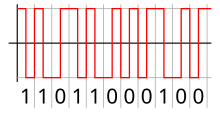Line code: Difference between revisions
Nasa-verve (talk | contribs) Adding reflist template -- need for refs to show up! :) |
Nasa-verve (talk | contribs) cleanup refs |
||
| Line 19: | Line 19: | ||
After line coding, the signal is put through a "physical [[channel (communications)|channel]]", either a "[[transmission medium]]" or "[[data storage medium]]".<ref name="paulsen"> |
After line coding, the signal is put through a "physical [[channel (communications)|channel]]", either a "[[transmission medium]]" or "[[data storage medium]]".<ref name="paulsen"> |
||
Karl Paulsen. [http://www.tvtechnology.com/media-servers/0150/coding-for-magnetic-storage-mediums/186738 "Coding for Magnetic Storage Mediums"].2007.</ref><ref>{{cite|author=Abdullatif Glass, Nidhal Abdulaziz, and Eesa Bastaki|url=http://ro.uow.edu.au/cgi/viewcontent.cgi?article=1285&context=dubaipapers|title=Slope line coding for telecommunication networks|year=2007|p=1537|journal=IEEE International Conference on Signal Processing and Communication|publisher=IEEE|location=Dubai|quote=Line codes ... facilitates the transmission of data over telecommunication and computer networks and its storage in multimedia systems.}}</ref> |
|||
Karl Paulsen. |
|||
[http://www.tvtechnology.com/media-servers/0150/coding-for-magnetic-storage-mediums/186738 "Coding for Magnetic Storage Mediums"]. |
|||
2007. |
|||
</ref><ref> |
|||
Abdullatif Glass, Nidhal Abdulaziz, and Eesa Bastaki. |
|||
[http://ro.uow.edu.au/cgi/viewcontent.cgi?article=1285&context=dubaipapers "Slope line coding for telecommunication networks"]. |
|||
2007. |
|||
p. 1537. |
|||
quote: "Line codes ... facilitates the transmission of data over telecommunication and computer networks and its storage in multimedia systems." |
|||
</ref> |
|||
Sometimes the characteristics of two very different-seeming channels are similar enough that the same line code is used for them. The most common physical channels are: |
Sometimes the characteristics of two very different-seeming channels are similar enough that the same line code is used for them. The most common physical channels are: |
||
* the line-coded signal can directly be put on a [[transmission line]], in the form of variations of the voltage or current (often using [[differential signaling]]). |
* the line-coded signal can directly be put on a [[transmission line]], in the form of variations of the voltage or current (often using [[differential signaling]]). |
||
Revision as of 19:51, 21 May 2014
This article includes a list of references, related reading, or external links, but its sources remain unclear because it lacks inline citations. (February 2014) |






In telecommunication, a line code (also called digital baseband modulation or digital baseband transmission method) is a code chosen for use within a communications system for baseband transmission purposes. Line coding is often used for digital data transport.
Line coding
Line coding consists of representing the digital signal to be transported by an amplitude- and time-discrete signal that is optimally tuned for the specific properties of the physical channel (and of the receiving equipment). The waveform pattern of voltage or current used to represent the 1s and 0s of a digital data on a transmission link is called line encoding. The common types of line encoding are unipolar, polar, bipolar, and Manchester encoding.
For reliable clock recovery at the receiver, one usually imposes a maximum run length constraint on the generated channel sequence[citation needed], i.e., the maximum number of consecutive ones or zeros is bounded to a reasonable number. A clock period is recovered by observing transitions in the received sequence, so that a maximum run length guarantees such clock recovery, while sequences without such a constraint could seriously hamper the detection quality.[citation needed]
After line coding, the signal is put through a "physical channel", either a "transmission medium" or "data storage medium".[1][2] Sometimes the characteristics of two very different-seeming channels are similar enough that the same line code is used for them. The most common physical channels are:
- the line-coded signal can directly be put on a transmission line, in the form of variations of the voltage or current (often using differential signaling).
- the line-coded signal (the "baseband signal") undergoes further pulse shaping (to reduce its frequency bandwidth) and then modulated (to shift its frequency) to create an "RF signal" that can be sent through free space.
- the line-coded signal can be used to turn on and off a light source in free-space optical communication, most commonly used in an infrared remote control.
- the line-coded signal can be printed on paper to create a bar code.
- the line-coded signal can be converted to magnetized spots on a hard drive or tape drive.
- the line-coded signal can be converted to pits on an optical disc.
Unfortunately, most long-distance communication channels cannot transport a DC component[citation needed]. The DC component is also called the disparity, the bias, or the DC coefficient. The simplest possible line code, called unipolar because it has an unbounded DC component, gives too many errors on such systems.
Most line codes eliminate the DC component – such codes are called DC-balanced, zero-DC, DC-free, zero-bias, DC equalized, etc.[citation needed] There are three ways of eliminating the DC component:
- Use a constant-weight code. In other words, each transmitted code word is corrected such that every code word that contains some positive or negative levels also contains enough of the opposite levels, such that the average level over each code word is zero. For example, Manchester code and Interleaved 2 of 5.
- Use a paired disparity code. In other words, the transmitter has to make sure that every code word that averages to a negative level is paired with another code word that averages to a positive level. Therefore it must keep track of the running DC buildup, and always pick the code word that pushes the DC level back towards zero. The receiver is designed so that either code word of the pair decodes to the same data bits. For example, AMI, 8B10B, 4B3T, etc.
- Use a scrambler. For example, the scrambler specified in RFC 2615 for 64b/66b encoding.
Unfortunately, several long-distance communication channels have polarity ambiguity.[citation needed] There are three ways of providing unambiguous reception of "0" bits or "1" bits over such channels:
- differential coding
- MLT-3 encoding
- invert the whole stream when inverted syncwords are detected
Line coding should make it possible for the receiver to synchronize itself to the phase of the received signal. If the synchronization is not ideal, then the signal to be decoded will not have optimal differences (in amplitude) between the various digits or symbols used in the line code. This will increase the error probability in the received data.
It is also preferred for the line code to have a structure that will enable error detection. Note that the line-coded signal and a signal produced at a terminal may differ, thus requiring translation.
A line code will typically reflect technical requirements of the transmission medium, such as optical fiber or shielded twisted pair. These requirements are unique for each medium, because each one has different behavior related to interference, distortion, capacitance and loss of amplitude.[citation needed]
Common line codes
- AMI
- Modified AMI codes: B8ZS, B6ZS, B3ZS, HDB3
- 2B1Q
- 4B5B
- 4B3T
- 6b/8b encoding
- Hamming Code
- 8b/10b encoding
- 64b/66b encoding
- 128b/130b encoding
- Coded mark inversion (CMI)
- Conditioned Diphase
- Eight-to-Fourteen Modulation (EFM) used in Compact Disc
- EFMPlus used in DVD
- RZ — Return-to-zero
- NRZ — Non-return-to-zero
- NRZI — Non-return-to-zero, inverted
- Manchester code (also variants Differential Manchester & Biphase mark code)
- pulse-position modulation (a generalization of Manchester code)
- Miller encoding (also known as Delay encoding or Modified Frequency Modulation, and has variant Modified Miller encoding)
- MLT-3 Encoding
- Hybrid Ternary Codes
- Surround by complement (SBC)
- TC-PAM
Optical line codes:
See also
- Channel coding
- Source coding
- Modulation
- Physical layer
- Self-synchronizing code and bit synchronization
References
- ^ Karl Paulsen. "Coding for Magnetic Storage Mediums".2007.
- ^ Abdullatif Glass, Nidhal Abdulaziz, and Eesa Bastaki (2007), "Slope line coding for telecommunication networks", IEEE International Conference on Signal Processing and Communication, Dubai: IEEE: 1537,
Line codes ... facilitates the transmission of data over telecommunication and computer networks and its storage in multimedia systems.
{{citation}}: CS1 maint: multiple names: authors list (link)
 This article incorporates public domain material from Federal Standard 1037C. General Services Administration. Archived from the original on 2022-01-22. (in support of MIL-STD-188).
This article incorporates public domain material from Federal Standard 1037C. General Services Administration. Archived from the original on 2022-01-22. (in support of MIL-STD-188).
External links
- Line Codes Analyzer: tool for graphical comparison of line codes
- Line Coding Lecture No. 9
- Line Coding in Digital Communication

